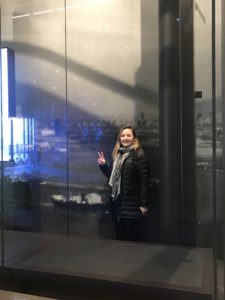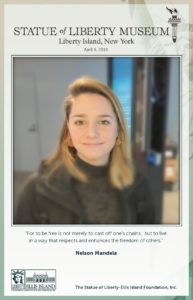Ladies of Liberty: Sarah Frankel, Senior Production Manager at ESI Design
Posted October 7, 2019
In May 2019, the new Statue of Liberty Museum opened on Liberty Island with experience and exhibits by ESI Design. The new museum is part of a $100 million Liberty Island-wide beautification effort that is funded by our clients, The Statue of Liberty-Ellis Island Foundation.
To celebrate we’re sharing the stories of some of the talented people who have worked for over five years to bring this world-class museum from concept to completion.
In this edition, you’ll hear from Sarah Frankel, a Senior Production Manager at ESI Design, who worked on the experience and exhibit design for the museum. Inspired by the Statue from an early age long before she started a career as a lighting designer, Sarah has a unique appreciation for Lady Liberty’s role as a symbol of light amid darkness.

Name: Sarah Frankel
Job Title: Senior Production Manager, ESI Design
Years of Experience: 10+
Age: 32
Nationality: American
Education: B.F.A Theater Design & Technology, Concentrating in Lighting Design, SUNY Purchase Conservatory of Theater Arts & Film; M.A Museum Exhibit Design, SUNY FIT
What was your first encounter with the Statue of Liberty?
Sarah Frankel, Senior Production Manager: My parents brought me to NYC and the Statue of Liberty when I was an infant. I was born and raised in Boulder, Colorado, so it was my first trip to a big city. Since I was so young, I don’t have any concrete memories of seeing the Statue for the first time. However, the vastness and craziness of NYC definitely made an impact on my forming mind. I’ve always had a deep-rooted desire to be a part of the hustle and bustle of NYC, and this trip was the beginning of that dream!
What was your role on the project? What did that mean for you day-to-day?
SF: I’m a Production Manager at ESI Design, which means I get to produce our designs and make them a reality. I work with our design team to ensure ideas are feasible, responsible, and cutting-edge. Then I work with vendors and fabricators to budget, prototype, fabricate, and install. It’s a crazy all-encompassing job that changes every single day, which is why I love it.
The Statue of Liberty Museum is one of the first projects I started working on when I joined ESI Design, so I got to be involved from conception straight through to installation and opening day. The design faced specific challenges from the beginning – a relatively small exhibit footprint, an extremely high expected visitorship, and a need to be as accessible as possible to people of all abilities and languages. That alone was quite a challenge! Then, add on top of that, there were the logistics of actually building a museum on an island in New York Harbor. The exhibits had to be installed during a small window of open public hours, everything had to be shipped over by barge. The entire museum had to be built to withstand harsh marine conditions and thousands of visitors each day. Some days were really hard, but the team that built this museum was fantastic and the end result is excellent.

You just opened a new museum for the Statue of Liberty — how does that feel? What does that mean to you?
SF: Working on the Statue of Liberty Museum has been doubly meaningful to me. First, I was inexplicably obsessed with the statue when I was very young. For Halloween, I dressed as Lady Liberty several years in a row. I don’t remember why I loved her so much, but looking back as an adult, it makes sense that I was drawn to the symbol of a strong independent lady, providing light for New York Harbor (a lady lighting designer!). Secondly, as an adult who has a degree in Museum Exhibit Design, opening such an iconic museum has been a once in a lifetime opportunity. I feel so lucky to have been able to work on a museum with such a good message. Given the current political climate, the museum helps visitors understand what liberty has meant historically, and how we can question and embrace the idea of liberty in the future. I really could not have asked to be on a better or more relevant museum project at this time in my life.
Why is having a museum dedicated to the Statue of Liberty important?
SF: I think having a museum that marries a physical monument to the questioning and contemplation of a conceptual ideal is very important. Unlike other museums, the Statue of Liberty Museum does not merely reflect on the history of an object, it encourages visitors to think broadly about the ideal of liberty and how it applies presently. Critical thinking about what freedom and liberty means to the world is of the upmost importance right now.

After working on this project, has your concept of liberty evolved?
SF: It has been interesting to experience to observe how my understanding of “liberty” has changed over the course of this project. We started working under a Democratic administration, in a time when I thought that our country was moving toward a more inclusive government. However, we finished the project under a very different political climate and administration. I am often questioning why I am able to live freely and with a basic sense of liberty, and why others are not. When we started the project, liberty was a word that I had to contemplate often. It was concept that I thought was embodied by our culture and inherent in being a US citizen. Now, liberty seems like a lost concept, something that we should be reinvigorating with a new sense of purpose. I’m still working on my ideas about how we can do better as a community and how we can make liberty an accessible ideal for everyone.
What were the steps in your journey to this iconic project?
SF: Well, I suppose it all comes down to the fact that I was born severely pigeon toed. Because of this “defect”, my mom enrolled me in a ballet class at age 3 (to naturally train my body to turn my feet out). That one ballet class turned into many ballet, tap, jazz, and hip hop classes. Those dance classes led me to performance and theater. And, without my failed attempt at acting, I never would have gone into theatrical lighting design and moved to NYC to pursue a degree from the Conservatory for Theater Arts and Film at SUNY Purchase. While honing my lighting skills during my undergraduate degree, I realized that I was also interested in telling a story through the use of physical space, objects, and self-directed exploration – this led me to pursue my M.A in Museum Exhibit Design at SUNY FIT. My understanding of lyrical movement and of narrative driven lighting and physical space have led me to a career at ESI.
Since you started your career, what’s the biggest change you have seen in the world of design?
SF: One of the most personal and tangible changes I’ve witnessed is the shift in the lighting design industry. When I first started designing lights, I was focusing huge incandescent static lights and swapping gels by hand – now, everything is automated, high-powered LED, and usually coupled with projection and video-mapping. Because of technological advances, designers are becoming masters of several arts instead of one art. A lighting designer can no-longer be “just a lighting designer” – they have to have an understanding of the narrative environment, the impact of physical space, and they likely need to have a broad understanding of projection, audio, and automation. It’s design forward, and we’re starting to see amazing new multi-disciplinary designers and design firms emerge all around the world.

What advice would you give to women who want to follow in your footsteps?
SF: My advice? Don’t disqualify yourself.
Throughout my life, I have never stopped to question my intuition about my career – I’ve always made a decision about where I wanted to be, and then ran full-force in that direction. Even if I didn’t perfectly fit into a certain job description, I applied anyway and asked questions along the way. I’ve always tried to not sell myself short, and to be confident that my varied life experiences might give me the upper hand when compared to a perfectly qualified applicant.
If you were giving a tour of the new museum, what would be your top highlight?
SF: I have so many favorite artifacts and design nuances throughout the museum. However, my favorite artifact is probably the giant wrench used to tighten the (even more giant) bolts used to secure the statue to the pedestal. The wrench head is bigger than the largest human head! It is just such a fantastical yet utilitarian memento from the construction of Lady Liberty. The wrench speaks to how every aspect of the construction of the statue was completely innovative at the time — unique tools for a unique lady. The wrench is on display in the Constructing Liberty section of the museum.
About ESI Design
ESI Design transforms places into dynamic experiences that engage audiences, solve complex challenges, and deliver lasting results. From our roots reinventing the Brooklyn Children’s Museum into one of the country’s first interactive museums, ESI Design has defined the field of experience design for over forty years, fundamentally changing how people connect with brands, organizations, cultural institutions and, most importantly, each other.
To read the rest of the interview series, click here. If you have any questions for Sarah, sound off in the comments!


Join The Conversation